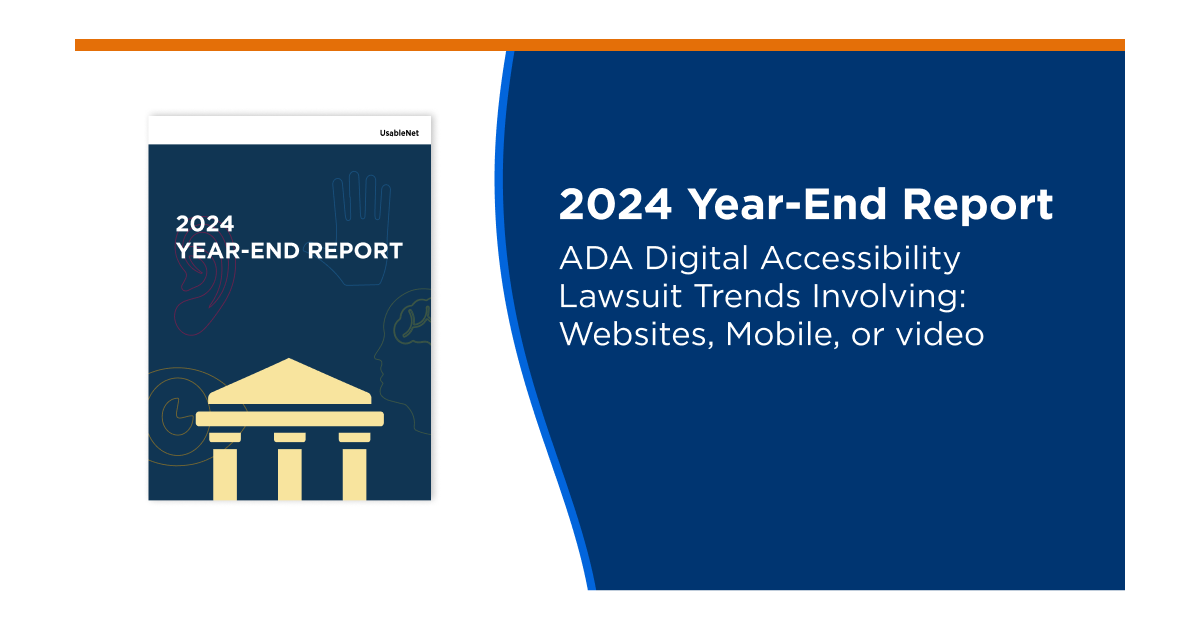It’s no secret that we closely track everything related to digital accessibility here at UsableNet, and that means that we track digital lawsuits particularly closely.
(Our data was even used for an article in The Wall Street Journal.)
We track both federal and state ADA-related lawsuits, downloading and assessing all ADA dockets. The digital-related lawsuits are then carefully monitored and become crucial sources of our data.
We put so much time and energy into this tracking methodology because it gives us solid, actionable data that we can bring to our clients. This year, for example, we were able to compile new ways to create more inclusive data based on our midyear 2021 lawsuit data report.
Let’s take a look at some of our 2021 findings like what's a typical week of digital accessibility lawsuits, what's generally included in an ADA website claim, and what you can do now to improve accessibility and avoid ADA lawsuits.
We also shared this data as part of our webinar, "How to apply Midyear 2021 ADA lawsuit data to your content," watch it here.
A Typical Week of Digital Accessibility Lawsuits
As of the middle of 2021, this is what a typical week will consist of when it comes to digital accessibility lawsuits:
- 70-90 suits are filed weekly
- 20% of cases are filed through the state (and mostly in California) and 80% are federal
- 12 individual plaintiff firms file 80% of lawsuits
- 20 plaintiffs file 59% of digital accessibility ADA lawsuits
- New York and California make up 81% of locations where the suits are filed
- There are often clusters of filings by a company’s industry (past examples have been automotive companies, colleges, and medical brands).
The reality is that there’s a big year ahead for ADA lawsuits. Plaintiffs are frequently winning the suits (especially in California), and more plaintiff lawyers are seeing the appeal of working digital ADA suits. Both video and apps are picking up steam as targets for ADA suits.
Keep in mind that as more plaintiffs and law firms search for more targets, they’ve started to shift their gaze from massive corporations to mid-sized companies. These businesses often have fewer in-house law resources, meaning that costs could drive settlements up. 74% of the top e-commerce brands have already received digital accessibility suits.
What’s in a Typical ADA Website Claim?
While nothing requires that ADA lawsuit claims have these things in common, most standard digital ADA lawsuit claims involve the following:
- A plaintiff who is blind (or deaf for video)
- The plaintiff has made multiple claims before
- There’s often an identified screen reader issue for the user, alongside a list of WCAG issues
- Many lawsuits are now starting to include accessibility issues associated with widgets (this makes up 9% of recent lawsuits)
How to Improve Your Digital ACCessibility Now
With so many brands being targeted (and not just enormous corporations with big bank accounts and in-house lawyers), it’s important to take steps to protect your business against an ADA lawsuit right away. Afterall, ADA lawsuit costs are more than just the settlement.
These are the immediate actions your company can take now:
- Take an immediate inventory of your websites, apps, PDFs, and online multimedia.
Search for accessibility issues, looking for high-target issues on top-used pages and features. Run an automated audit, as this will catch plenty of the low-hanging fruit type of issues that plaintiffs look for quickly to find a target.
- Draft and publish an accessibility statement right away. Get your business’s leadership on board (letting them know it can help mitigate the risk of lawsuits will certainly help), and publish it online in an easy-to-find place on your site. Explain what steps you’re taking to improve accessibility and that it’s a priority for your business.
- Document all accessibility efforts. This is a good step to help show that you prioritize accessibility in case there is a lawsuit in the future.
- Test for WCAG issues. WCAG 2.1 is commonly respected as the standard guidelines, even though there’s no official ruling regarding that. After making improvements to your site, run another automated audit to see how well your digital presence is performing.
- Always perform user testing. Work with testers from the disabiity community and experienced in using assistive technology like screen readers. Real users can find issues that automated audits miss, ensuring that nothing will go unnoticed.
Need help protecting your business against ADA lawsuits? We have the experience and technology to help you create an accessibility strategy. Learn more here.










